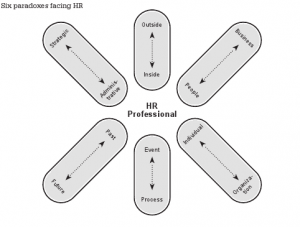I attended the Nasscom India HR Conference in Chennai last week. From conversations in recent years, I’ve noticed a lot of interest and curiosity about the India HR world externally as well.
Here’re some of my key notes and perspectives from the conference:
- One of the most encouraging discussions to hear was from senior business leaders, recognizing that HR leaders can be actively considered as CEO succession candidates. There was recognition at the CEO level that HR leaders can have a tremendous impact on the business, due to immense amount of knowledge about the talent, organization, culture and the ability to engage with them successfully. What would it take for an HR leader to be considered? There was a feeling that business, financial and strategic skills can improve.
- It would be important to have HR experts on the boards of companies (this came from senior business leaders). Currently, there seems to be little expert knowledge or in-depth discussions on company boards.
- Importance of having a strong personal value system and caring attitude towards employees (‘H’ in Human Resources) was highlighted. This approach from leaders and HR was seen to have a high impact on employee engagement.
- It is impactful for business leader development to rotate to HR roles but seems to not sufficiently happen the other way. Most panelists felt that it would be very important for an HR leader to have done at least one job outside HR. HR professionals sometimes do not feel confident or motivated to take up external assignments. Talent development support and nurturing within the function would enable more of this.
- The need for HR to be competent business partners – moving beyond processes and policing was highlighted multiple times. Seems like there is a lot of work for the HR teams to progress towards becoming credible business partners.
- HR is still seen as reluctant adopters of new technologies in organizations – in some cases, even disinterested.
- Performance Management was the most active session attended. Most questions and interest were focused on the details of administering a ‘no bell curve’ system. This could be among the most active areas for HR and organizations in coming years. Companies like Adobe who have moved away from the bell curve system received most of the questions and interest.
- It is important for middle managers or first time leaders to build self awareness, be seen as team and organization builders, and build a strategic perspective, if they want to progress to senior leadership roles.
- Some of the basic areas and processes require attention. A recent case in the education industry involving insufficient reporting, employment background checks and records showed up in a Bangalore school, where a teacher with a very worrying negative work history was not identified. Another area seems to be the pervasiveness of fake certificates and resumes.
- Interest in topics such as gamification (especially in the start-up community) and hackathons seem to be growing.
- There is still a long way to go for HR in using data and analytics as a strong base for decisions. Predictive modeling is used by very few companies.
- Attracting employees and leaders globally due to growth and acquisition in new geographies seems to be a topic of growing importance.
- Skill building and employability in schools and organizations were seen as important areas to ensure continuous availability of quality talent. Working together in teams and leadership development were seen as active areas for improvement and development at all stages (recent post on employability ).
- Under the new Companies Act, certain class of profitable entities are required to spend at least two per cent of their three-year annual average net profit towards CSR activities. This seems to hold promise for development activities.
- The Nasscom report specifying salary difference between men and women being almost a third, was shared. Looks like companies in India have to dig deeper into this topic and work out related actions.
- Among notable missing topics from my perspective was neuroscience/brain studies and impact on leadership and organizations. It would also have been useful to hear about how investors look at HR/leadership practices, global perspectives and references to topics like mindfulness or status/impact of the occupational health area.
It is obvious that managing through fast paced changes happening outside and inside organizations requires a continuous learning and improvement mindset. The strong link to global business and competitive environment leaves little room for complacence. This holds many opportunities for HR and also requires intensive, focused effort to upgrade competencies and mindset.
In my observation, HR in the IT/ITeS sector seems to have progressed faster due to heavy reliability on human capital development, fast growth, global acquisitions, diverse client base and connectedness. That said, most professionals and experts seem to acknowledge that a lot of work is still needed.
Best wishes to you and your teams.
If I have missed something or you have a different perspective, please comment.
Please do note that IT/ITeS HR represents only one part of India HR.




Recent Comments